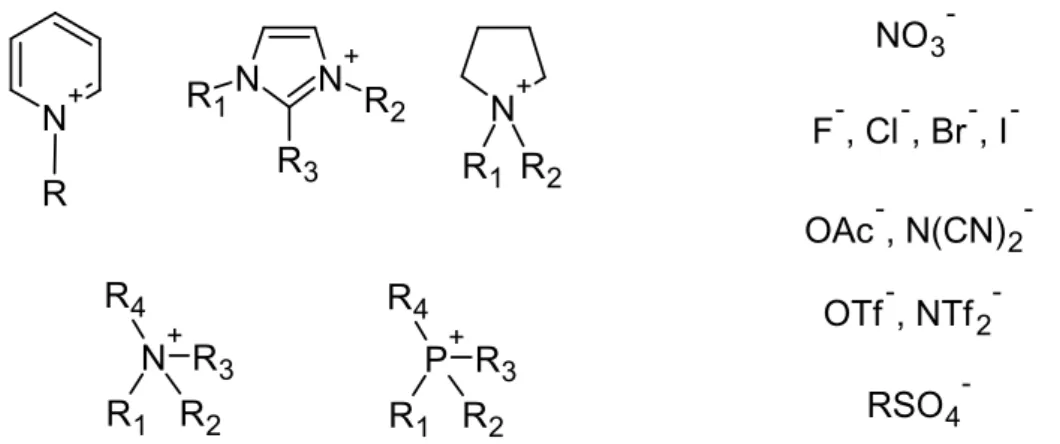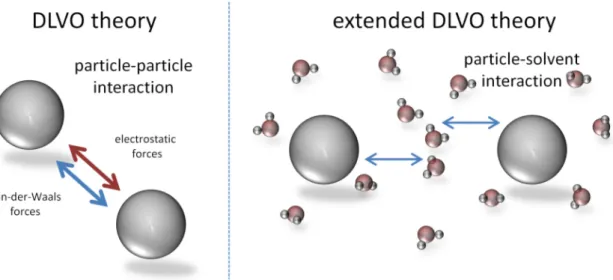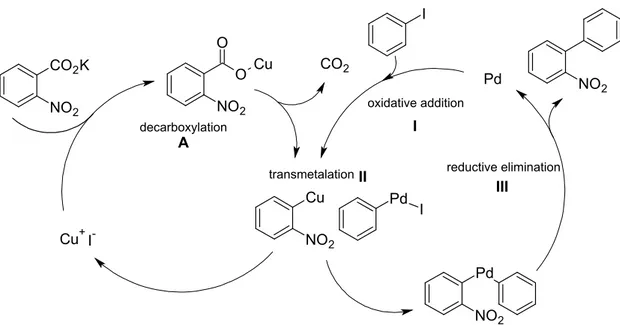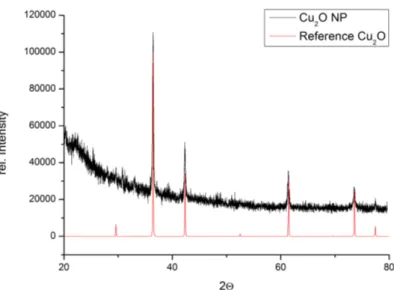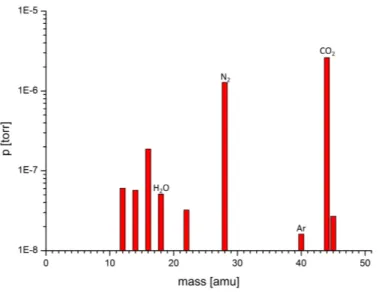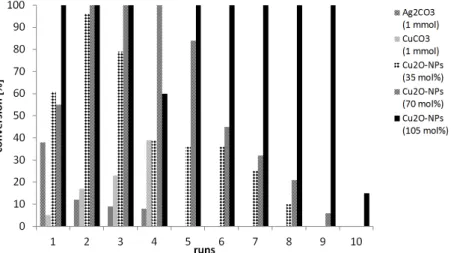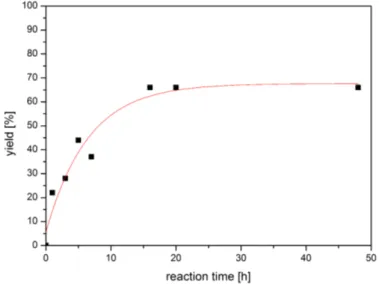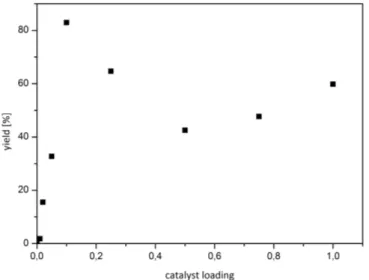Syntheses, Characterisation and Application of Nanoscale Catalysts
Inaugural-Dissertation zur
Erlangung des Doktorgrades
der Mathematisch-Naturwissenschaftlichen Fakultät der Universität zu Köln
vorgelegt von
Dipl. Chem. Michael Keÿler
aus Engelskirchen
Köln, im August 2014
(Gutachter)
Berichterstatter: Prof. Dr. Annette Schmidt (Zweitkorrektor)
Tag der mündlichen Prüfung: 10.10.2014
Acknowledgement
I would like to thank Dr. Martin Prechtl for giving me the opportunity to work on and to write my thesis in his group.
Furthermore, I want to thank Prof. Dr. Annette Schmidt for the preparation of the second report of this dissertation.
Dr. Sebastian Sahler and Dr. Lisa Czympiel are acknowledged for proofreading and linguistic revision of this work as well as all the help within the last years.
I want to thank all my colleagues, Jong-Hoo Choi, Christian Gedig, Maria Hentschel, Leo Heim, Silas Robke and Hannelore Konnerth for preparative support and helpful dis- cussion as well as for a great time in the lab.
Prof. Dr. Ning Yan and his whole group at the National University of Singapore are acknowledged for giving me the opportunity to work abroad, all the help during my stay in Singapore and the memorable and pleasant time.
Dr. Lasse Greiner and Dr. Sakthivel Mariappan are acknowledged for their support at the Dechema Instititute (Frankfurt a.M.) for TEM analysis.
Ralf Müller is acknowledged for XPS investigations, Dr. Christina Heinrichs and Ireneus Grzesiak are kindly acknowledged for support with XRD analyses. Furthermore, I want to thank Dr. Stefan Roitsch for TEM analyses and helpful discussion.
Special thanks are directed to the Evonik Foundation for nancial and personal sup- port during my PhD time. In particular, I would like to thank Susanne Peitzmann, Prof.
Dr. Wolfgang Leuchtenberger and my mentor Dr. Matthias Rochnia, who have always supported my scientic work.
I am grateful for the enduring support of my family and the personal back-up within the last nine years. Falco Fox and Christopher Klinkenberg are acknowledged for always giving a good advice or simply for listening.
Finally, I want to thank Norah for the support during my studies. I am deeply thankful for the time we have spent together and her patience during that time.
Abstract
In this work, immobilized metal- and metaloxide nanoparticles were used as nanoscale catalysts in chemical reactions. Palladium nanoparticles, which catalyze classical C- C cross-coupling reactions (Heck-, Suzuki- or Sonogashira reactions), were grafted in the pores of carbonized wood. Several recycling reactions with remarkable performance could be realized. Furthermore, Cu2O nanoparticles were synthesized in tetra-n-butyl- phosphonium acetate, an ionic liquid with high stabilizing potential and low melting point. These nanoparticles could be used as a recyclable decarboxylation catalyst for 2-nitrobenzoic acids and as a catalyst for Buchwald-Hartwig reactions. Depending on the reaction parameters or functional groups of the substrates, the catalyst showed mod- erate to excellent activity and recyclability. Inspired by the straight forward synthesis of palladium and copper oxide nanoparticles from simple metal salts with acetate ions as reductive species, a more general method for the synthesis of nanoscale materials has been developed in this work. Copper, silver, nickel oxide and zinc oxide nanoparticles have been synthesized via microwave irradiation in two dierent ionic liquids, as well as from two dierent precursors, respectively. Apparently, a wide range of nanostructures can be realized in ionic liquid systems with the assistance of acetate anions and without the necessity of ligands, surfactants, inert conditions or any further additives.
Besides some reviewing paragraphs, the ongoing experimental but unpublished work, which is in continuation of the above stated topics, is also presented, including deutera- tion experiments, deoxygenation reactions and decarboxylative cross-coupling reactions.
In sum, the syntheses, characterization and evaluation of nanoscale catalytic systems is presented. Examples for new nanoparticle/ionic liquid systems, new and already estab- lished catalyses, which have not been realized with nanoparticle catalysts in ionic liquids so far as well as their performance concerning activity, stability and recyclability have been investigated.
Kurzzusammenfassung
Immobilisierte Metall- und Metalloxidnanopartikel nden in dieser Arbeit Verwen- dung als nanoskalige Katalysatoren für chemische Reaktionen. So wurden z.B. Palladium- nanopartikel, als Katalysatoren für C-C-Kreuzkupplungsreaktionen, wie die Heck-, Suzu- ki- oder Sonogashirareaktion eingesetzt. Als Substrat für die Immobilisierung diente car- bonisiertes Holz, in dessen Poren die Partikel eingelagert wurden. Der geträgerte Kataly- sator konnte in allen drei Reaktionen mehrfach recycelt werden und lieferte dabei gute Ausbeuten der jeweiligen Kupplungsprodukte.
Darüberhinaus wurden Cu2O Nanopartikel in Tetra-n-butyl-phosphonium Acetat, einer ionischen Flüssigkeit mit stabilisierenden Eigenschaften und niedrigem Schmelzpunkt, dargestellt. Die Partikel dienten sowohl als Katalysator für Decarboxylierungsreaktionen von 2-Nitrobenzoesäurederivaten als auch für Buchwald-Hartwig-Reaktionen. In Abhän- gigkeit von Reaktionsparametern oder funktionellen Gruppen an den Edukten, zeigten die Katalysatoren eine durchschnittliche bis exzellente Aktivität und eine ebenso gute Recyklierbarkeit.
Inspiriert durch diese einfache und geradlinige Synthese von Palladium- und Kupferoxid- nanopartikeln wurde eine allgemeine Synthesemethode zur Darstellung von Nanomate- rialien in dieser Arbeit entwickelt. Dabei beruht die Partikelsynthese hauptsächlich auf der Reduktion einfacher Metallsalze durch Acetationen. Kupfer-, Silber-, Nickeloxid- und Zinkoxidnanopartikel wurden durch Mikrowellensynthese in zwei verschiedenen ionischen Flüssigkeiten und aus zwei verschiedenen Vorstufen (Präkursoren) dargestellt. Oenbar kann eine Vielzahl verschiedener Nanomaterialien in ionischen Flüssigkeiten unter Zuhil- fenahme von Acetationen dargestellt werden. Dabei kann auf die Verwendung von zu- sätzlichen Liganden, oberächenaktiver Substanzen, inerter Reaktionsbedingungen oder anderer Additive verzichtet werden.
Neben zwei zusammenfassenden Arbeiten geben weiterführende und auf den oben genann- ten Themengebieten basierende experimentelle Abschnitte einen Überblick über zusätz- liche Anwendungsgebiete der hier vorgestellten Cu2O Nanopartikeln, sowie von Pd/Cu bimetallischen Nanopartikeln, wie z.B. Deuterierungsexperimente, Deoxygenierungsreak- tionen und decarboxylierende Kreuzkupplungen.
Zusammenfassend werden in dieser Arbeit die Synthese, Charakterisierung und Bewer- tung nanoskaliger Katalysatorsyteme vorgestellt. Es werden Beispiele für neuartige Na- nopartikel/ionische Flüssigkeitssysteme vorgestellt, sowie bisher noch nicht mit Nano- partikeln realisierte Katalysen in ionischen Flüssigkeiten sowie deren Leistungsfähigkeit hinsichtlich Aktivität, Stabilität und Wiederverwendbarkeit untersucht.
Contents
1 Introduction 1
1.1 Introducing Remarks . . . . 2
1.2 Ionic Liquids . . . . 2
1.3 Nanoparticles and Nanoscale Structures . . . . 6
1.4 Catalyses . . . 12
2 Scientic Aim 19 3 Results and Discussion 21 3.1 Recyclable Nanoscale Copper(I) Catalyst in Ionic Liquid Media for Selective Decarboxylative C-C Bond Cleavage . . . 22
3.2 Ligand-free copper(I) oxide nanoparticle-catalysed amination of aryl halides in ionic liquids . . . 40
3.3 Fast track to nanomaterials: microwave assisted synthesis in ionic liquid media 53 3.4 Molecular Palladium Precursors for Pd0 Nanoparticle Preparation by Microwave Irradiation: Synthesis, Structural Characteriza- tion and Catalytic Activity . . . 71
3.5 Coupling Reactions in Ionic Liquids . . . 85
3.6 Palladium Catalysed Aerobic Dehydrogenation of C-H Bonds in Cyclohex- anones . . . 117
3.7 Nanoparticle Syntheses and Applications as Catalysts . . . 122
4 Summary and Outlook 133 5 Experimental 137 5.1 Analytics . . . 137
5.2 Syntheses of Ionic Liquids . . . 140
5.3 Nanoparticle Syntheses . . . 153
5.4 Nanocatalyses . . . 156
6 Concluding Remarks 167 6.1 List of Publications . . . 167
6.2 Reprint Permissions and Copyrights . . . 168
6.3 Contributions to Publications . . . 172
A Appendix 173 A.1 NMR-spectra . . . 173
A.2 IR-spectra . . . 206
A.3 ICP-OES . . . 211
A.4 ESI Mass Spectra . . . 213
A.5 Electron Microscopy . . . 216
B Abbreviations 221
Bibliography 223
List of Figures 231
List of Tables 237
Erklärung 239
1 | Introduction
Nano science plays an important and even further emerging role equally in academia and industrial research. Our everyday life is by now highly inuenced and related to achieve- ments arisen from technologies of the tiniest.13 On the one hand, people who are not familiar with these, often fear certain (or uncertain) threats and hazards accompanied with the term "nano".46 On the other hand, industrial companies distinguish techno- logical (and of course economical) opportunities in this area in order to develop new and ecient products.1, 4, 5, 7, 8
Figure 1.1: The amount of publications concern- ing nano technology has emerged within the last 30 years.
Apparently, academic scientists are supposed to take the role of an arbiter between both antagonists, to avert se- rious harm from our society and to ensure technological development and wealth.
What we today call "nano science" has its origins already back in the 17thcen- tury.911 Nano material based com- pounds and colloids, e.g. of gold, have already been synthesized in 1676 by A. Cassius and J. Kunckel, though lacking structural and chemical under- standing.12, 13 According to what we know today, is, that even the Romans have synthesized nanosized gold par- ticles to colour glasware.14 M. Fara- day was the rst who really recognized the synthesis of very small particles.15 Within the last 35 years, the science of metal and metal oxide nano structures
has developed with increasing velocity (Figure 1.1). Not only the synthesis of nano struc- tures by Bönnemann et al.16, 17 or the rst fundamental studies of so-called "ultra-ne"
particles conducted by C. Granqvist and R. Buhrmann18made these materials interesting for dierent applications in physics and chemistry as well as for medical purposes. The high expectations of earlier years are now critically reconsidered with respect to actual progresses in method development and technological advantages realized. In fact, there has to be a certain and considerable scientic benet by using nanoscale materials.
1.1 Introducing Remarks
Nowadays, nano-sized materials are well characterized since electron microscopy, X-ray and light scattering methods have evolved and have become standard techniques in to- day's laboratories.1921 Although widely used in biological, physical or chemical science there is an ongoing discussion about a satisfying denition of what nano materials really are. In principle, the word "nano" refers to a simple mathematical prex or factor 10−9. By this, nano materials should be sized between 1 and 1000 nm.
However, there are several inherent optical, electrical or chemical properties and charac- teristics, which are only attributed to a far smaller subset. These properties and char- acteristics are provided by nano structured compounds with new functionalities, which dier eminently from the respective counterparts in bulk state.22, 23 As a matter of fact, this denes a chemical compound as a (functional) material. Although there is no clear size-delimitation for "nano-characteristics", nano materials are dened by the European Commission to be in the range of 1-100 nm.24 Unless there is no clear and international accepted denition of the term "nano material", this dissertation and the terminology used herein is strictly guided by this proposal of the European Commission.
1.2 Ionic Liquids
Molten salts usually require high temperatures so as not to congeal. However, these com- pounds have aroused academic interest for the rst time in the early 1940s and were tentatively investigated. E. Heymann and H. Bloom belong to the rst in natural sciences, who took a deeper look at the physical and chemical properties of inorganic salts and their mixtures, e.g. melting point, electric conductivity and activation energy of ionic migra- tion.25 In many respects, the use of molten salts as solvents (initially for electrochemical reactions) was of major interest. As the melting points of classical inorganic compounds were too high for their convenient use in the lab and to extent the amount of investigable substances, usually alkali or earth-alkali uorides and alkali nitrates with melting points between 360-450◦C and 250-300◦C were used, respectively.
As the melting points of molten salts were still too high in order to investigate sensitive organic molecules, salt-like compounds with high ionic character exhibiting an even lower melting point, were re-discovered. These consisted of a (rather) organic cation and an inorganic anion. In fact, J. Weiner and S. Gabriel synthesised ethanol/ammonium nitrate already in 1888,26 whereas ethyl ammonium nitrate (EtNH3 NO3) was synthesized by P.
Walden in 1914.27 The terminus "molten salt" was regularly used till the 1970s.28 There- after, this class of organic/inorganic salts was renamed into "ionic liquids" (IL) and further developed. Molten salts should therefore only include melts of inorganic salts.29 Today ionic liquids are dened as chemical compounds merely consisting of poorly coordinated ion pairs, that melt below 100◦C. ILs which melt below 25◦C are called room temperature ionic liquids (RTIL) and are of certain preparative interest.30
1.2.1 Varieties of Ionic Liquids
A wide range of cations and anions in numerous combinations and variations are known today. The most common cation motifs are of pyridinium-, imidazolium-, pyrrolidinium-, ammonium- or phosphonium-type (Figure 1.2). The amount of normally applied anions outnumbers the corresponding cations by far. Usually weakly coordinating anions are used, but in principle all kinds of inorganic anions like halides, nitrate, tetrauoroborate, hex-
auorophosphate and sulfates as well as organic anions like triates (OTf, triuoromethyl- sulfonate), alkylsulphates, N-triates (NTf2, N,N -bis(triuoromethylsulfonyl)imide) or di- cyanamides are common.31, 32
NO3- F-, Cl-, Br-, I- OAc-, N(CN)2-
OTf-, NTf2- RSO4- N+
R
N+ R1N R2
R3
N+ R1 R2
P+R3 R4 R1 R2 N+R3
R4 R1 R2
Figure 1.2: Selection of cations and anions commonly used in ionic liquids.
Alkyl side chains of the cations can be substituted with various functional groups, which inuence the physico-chemical properties of the ionic liquid. For this reason, ILs are considered as "designer solvents".33 Common functionalisations are hydroxyl-,34 nitrile-35 or carboxylate groups.36 Even though ionic liquids are comparatively expensive, they bear numerous advantages in comparison to classical solvents. In contrast to commonly used solvents, ILs usually fulll more than one function within a chemical reaction which makes them interesting for "green" chemical applications. ILs can be used as (co-)solvents,37 promoters/catalysts,38 surfactants and ligands39 or reductive agents.40 The use of ionic liquids reduces or even avoids the extensive application of additives in many ways, leading to a signicantly lower degree of contamination of the reaction medium and nal products.
1.2.2 Properties of Ionic Liquids
The modern denition of ionic liquids separates them from classical molten salts. Despite the fact, that molten salts and ionic liquids build up ion clusters in their liquid state41and that both types of compound classes melt at relatively low temperatures, there are distinct dierences. Molten salts consist of inorganic anions and cations both bearing a denite and clearly localized charge. As classical solid state salts they build up a crystal lattice with a denite and highly symmetrical long range order. The arrangement of a three-dimensional network, bound together by strong inter ionic bonds, leads to high melting points of the majority of inorganic salts like sodium chloride (Table 1.1). These can be reduced by in- creasing the entropy within the crystal lattice, e.g. by combination of small anions and big cations (e.g. LiCl) or the use of salt mixtures, which directly leads to molten salts.42 On the contrary, an ionic liquid usually consists of an organic cation and an inorganic anion, like 1,3-dimethylimidazolium chloride (mmim Cl) or 1-butyl-3-methylimidazolium chloride (bmim Cl). The cation's charge is partly delocalized within the carbon structure or sometimes even delocalized over an aromatic ring-system.43 The ionic organic species do not have a spherical shape and are generally not symmetrical at all.44 Moreover, alkyl groups with a high degree of freedom lead to an inhomogeneous ionic structure of the ionic liquid and therefore the lattice energies can easily be overcome, so that the melting points of these compounds are low.45 A low tendency for hydrogen bond interactions46, 47 and a
big and unsymmetrical counter ion leads to a further decrease of the melting point.31, 48 However, like many other liquids, ILs show structural motifs even in the molten state. At rst glance, it is impossible to bring this in line with the inhomogeneous ionic structure.
It is, in fact, more a matter of sub-structure of lower order, which should not be mixed up with ionic long-range order, as J. Dupont and co-workers could show.39 Today, we know that the dierences between molten salts and ionic liquids do not lead to the replacement of one or the other, but rene their distinct application in physical or chemical investigations.
Table 1.1: Melting points of salts, molten salts and ionic liquids.29
melting point melting point
[◦C] [◦C]
NaCl 801 emim Cl 87
LiCl 615 emim NO3 38
mmim Cl 125 emim BF4 6
bmim Cl 65 emim CF3CO2 −14
Besides the above stated structural and electrical properties, ionic liquids show ex- tremely low vapour pressures. The negligible tendency for vaporisation is even true for higher temperatures. Their decomposition temperature is also very high but depends on side chains and functional groups.29 Some ionic liquids can be heated up to 350◦C and still show long-term thermal stability (12 h and more). The boiling points of many ionic liquids are not explicitly mentioned, because they are often coincidental with their decom- position points. Nonetheless, some ionic liquids, i.e. emim NTf2 or dmim NTf2, have been successfully distilled at 300◦C and 6 mbar within 4-6 h by K. Seddon, J. Widegren and co-workers in a Kugelrohr apparatus.49 Mainly imidazolium based ionic liquids show high thermal stability. The fractions of decomposed IL in the distillate were usually below 1%
and could not be distinguished from initial contamination. In sum, many ILs show a wide liquid region (∆T = Tboil - Tmelt = 150-310◦C) which is far beyond that of for instance water (∆T = 100◦C) or dichloromethane (∆T = 136◦C).
Although ionic liquids are made up of ion clusters,41 they cannot be treated as polar sol- vents in general. Many ILs are hardly miscible with water and show phase separation.
Polarity, but also acidity and basicity dier tremendously according to substituents and functional groups. These properties have been summarized for conventional solvents and are named Kamlet-Taft parameters α, β and π∗.50 P. Jessop and D. Jessop have deter- mined the Kamlet-Taft parameters for several ionic liquids:51 α, β and π∗-values vary strongly depending on the combination of cation and anion. Hence, ionic liquids show very favourable solvating properties for a broad range of polar and non-polar substances.
Other remarkable properties of many ionic liquids are relatively low electrical and thermal conductivities, which is surprising, due to their ionic nature. They also exhibit high spe- cic heat capacities, high viscosity and frequently show chemical and physical inertness.
Since ionic liquids dier signicantly in their physico-chemical properties (see Kamlet-Taft parameters) a prediction of the latter is, if not impossible, at the very least not reliable.
1.2.3 Applications of Ionic Liquids
Even though ionic liquids show remarkable properties, up to now there is limited indus-
process in which ILs play a role, is "ionikylation".52 This represents the synthesis of gaso- line additives with high research octane numbers (RONs) based upon iso-butane to yield trimethylpentanes. The used ionic liquid (bmim AlCl4) replaces hazardous hydrouoric acid and sulfuric acid, which is highly benecial due to the low toxicity of the ionic liquid.
AlCl3, HCl and CuCl are added to the ionic liquid as catalyst precursors and to provide sucient acidity. Another process including ionic liquids was presented by BASF and called BASIL process.53 To be precisely, alkylimidazoles were added as a base and after protonation they form the ionic liquid which can easily be separated. That means, the imidazolium IL itself is not active in the whole reaction at all. A more convincing appli- cation for ILs could be their use in batch reactions for the synthesis of ne chemicals. R.
Giernoth et al. showed that ionic liquids can act as pharmaceuticals simply by function- alization of imidazolium-based ionic liquids in combination with various anions.54 They show remarkable antibiotic and analgesic activity. Due to their large liquid region, ionic liquids are used as transportation uids for thermal energy (heat carrier) in solar thermal energy plants.55 bmim BF4 for example shows liquid behaviour between -71◦C and 450◦C (thermal degradation is not monitored over a long period). Due to their high heat capac- ity, ionic liquids are also superior as (thermal) energy storage media. The assembly and performance of lithium ion batteries could be signicantly improved by using ionic liquids as electrolyte. In 2005 N. Takami et al. presented a lithium/air-cell working for 56 days with a discharge capacity of 5,360 mAh/g by using emim NTf2 commercially available batteries show capacities of 1,700-2,500 mAh.56
Although the usage of ionic liquids to dissolve biomass seems to be a new and upcoming trend for the usage of ionic liquids, C. Graenacher already stated in 1934, that cellulose could be dissolved in "halide salts of nitrogen containing bases", such as 1-benzylpyridinium chloride or 1-ethylpyridinium chloride, at temperatures above 100◦C.57However, in those days the utilization of biomass as feedstock material has not been of economical interest as it is today. In fact, the dissolution of biomass and the separation of its components to make the latter suitable as feedstock for the synthesis of future base- and ne chemicals is a major goal in ionic liquid science.58 Lignin and (hemi-)cellulose belong to the largest and naturally most abundant resources. Common ionic liquid motifs for solubilisation of cellulose are pyrrolidinium and imidazolium chlorides.59 While the synthesis of furfural and its derivatives is already advanced concerning the lab-scale,60 all processes for indus- trial applications still show economical disadvantages and are technically demanding. It would be desirable to exploit this source of raw material because the recent key source for chemicals of great value - crude fossil oil - will run short in a few decades. A comprehensive overview about current techniques and technologies is given elsewhere.61
1.2.4 Nanoparticles in Ionic Liquids
In chemical catalyses the interaction between catalyst, substrates/educts, products and surfactants plays a critical role concerning the outcome of the reaction. Dealing with nanoparticles in ionic liquids, the IL is simultaneously the solvent and surfactant. Dur- ing nanoparticle syntheses, the ionic liquid provides a reaction matrix for the synthesis of the crystal seeds and the particle ripening, but also prevents intensive particle growth and aggregation by so-called electrosteric shielding (Figure 1.3 C, D).30This is a combina- tion of coulombic repulsive (electrostatic) interaction, which is known from ionic additives (Figure 1.3 B) and steric shielding, arising from bulky surfactants (ligands or polymers, Figure 1.3 A). In contrast to surfactants which are anchored to the particle surface, co- ordinated and unbound IL molecules are in a dynamic equilibrium. Functional groups of the ionic liquid's side-chains, like CN, OH, NH2 etc. can intensify the interaction with the
nanoparticle surface62, 63 and improve the shielding of the nanoparticle (Figure 1.3).64, 65 During a catalytic reaction, catalyst and educt form an activated complex. On the one hand, this is supposed to happen directly on the surface of a nanoparticle, which is com- monly true in hydrogenation reactions in ionic liquids. On the other hand, the nanoparticle can also serve as a reservoir for molecular catalyst species. The latter can be leached from the particle surface either by oxidative addition/insertion or stepwise by dissolution of small metal clusters and further leaching. Cross-coupling reactions for example are sup- posed to be catalyzed by molecular species and do not form educt/catalyst complexes on the surface of nanoparticles. The true mechanism for the generation of molecular catalyst species out of a nanoparticle reservoir is hardly investigated and only little understood as Beletskaya et al. recently showed.66
Figure 1.3: Surfactants of particles: A amines as surfactants (steric shielding), B ionic salts as surfactants (electrostatic shielding), C ionic liquids as surfactant (electrosteric shielding), D functionalized ionic liquids as surfactants (electrosteric shielding).
1.3 Nanoparticles and Nanoscale Structures
Nanoparticles and other nano structures of higher dimensionality are known in manifold geometries and symmetries.67, 68 Triangular, hollow, octahedral, tetrahedral and of course spherical shapes are well known for nanoparticles. Rods, wires, belts and ribbons can be realized for one-dimensional nano structures, whereas platelets and akes are consid- ered to be two-dimensional structures. Nanoscale lattices and frameworks rather belong to three-dimensional nano structures. However, a distinct subdivision into these four di- mensionalities cannot be made: A clear dierentiation between these objects is dicult, because they always show a three-dimensional extension. The prexes 0D, 1D, 2D and 3D rather indicate the major growth directions (Figure 1.4). Nanoparticles are known for the majority of metals, e.g. in their elemental form, as transition metal chalcogenides and halides or as composition of main group elements. Already in the early 20th century,
concerning their use as catalysts in chemical reactions, although they were often called col- loids or colloidal particles, due to their behavior to be incorporated in stable dispersions.69 In literature phrases like nano cluster, nano powder or nano crystals are sometimes uti- lized. The latter refers to mainly inorganic and highly crystalline nano particles, whereas nano clusters should be sized below 10 nm. Nano powders, however, are supposed to repre- sent agglomerates and aggregates of nanoparticles with sizes below 1000 nm. Nevertheless, those phrases are not common nor internationally accepted.70
Figure 1.4: Zero-, one- and two-dimensional nano structures.
1.3.1 Syntheses of Nanoscopic Materials
Nanometer sized structures have not been invented or rstly realized by mankind, but are naturally abundant in ne powders like ashes or dusts, in minerals like opals, in the biosphere (e.g. on surfaces of leaves or animal feet) or are formed by viruses.71 Though, most of the anthropogenic nano materials are synthesized accidentally in industrial com- bustion or during the production of construction materials. For the specic synthesis of nanoparticles there are two main principles: The top-down method, including grinding and milling of powders, ablation techniques from targets or etching. On the contrary, the bottom-up methods involve precipitation, sol-gel processes, vapour depositions, lithography or epitaxy.72, 73 For chemical applications, solvothermal syntheses of nano materials are very popular and well investigated.74, 75 They bear the advantage to control size and shape by adjusting the reaction parameters without the necessity of technically sophisticated set- ups. Moreover, doping and surface functionalisation can be easily performed by adding the corresponding additives to the reaction medium.
The principle of the nanoparticle formation is often referred to the LaMer-mechanism introduced by V. K. LaMer and co-workers in the early 1950s.76, 77 In short, the LaMer- mechanism proposes, that nucleation can only occur in supersaturated (precursor-) solutions. Initially the concentration of the pecursor should rapidly increase (phase I Figure 1.5). In accordance with statistical mechanics, the energy barrier of nucleation can only be surmounted in supersaturated solutions, where the probability of bimolecular stepwise additions is suciently high (phase II Figure 1.5). The formation of nuclei leads to a decrease of the concentration in the solution which ceases the nucleation. Further growth of each nucleus by diusion controlled agglomeration (e.g. Ostwald ripening) leads to consumption of the particle precursor (phase III Figure 1.5). This temporal separation of nucleation and growth is the key idea of the LaMer-mechanism.
In contrast, M. A. Watzky and R. G. Finke proposed a dierent course of events.78 They introduced a mechanism in which again, nucleation and growth are separated in time, but the nucleation is of slow and of continuous manner without the dependency on su- persaturated solutions. Furthermore, the particle growth is fast and the rate determining
step is the auto-catalytic and surface-controlled incorporation of monomers to the particle.
This means, particle growth is not controlled by diusion. The proposed mechanism is conrmed by their experimental data showing the precipitation of Ir nanoparticles with [Bu4N]9P2W15Nb3O62 as surface stabiliser. It is also in good agreement with the theory and ndings of J. Turkevich and co-workers from 1951 who showed that nanoparticles can also be synthesized from a bittern not showing supersaturation.79
Figure 1.5: Graphical sketch of the LaMer-mechanism. I) Increasing precursor concen- tration, II) self nucleation and III) diusion controlled growth of nano structures. Adapted from ref.76
Of course, there are plenty of dierent types of precursors for the solvothermal synthesis of nanoparticles. The most convenient way to synthesise particles is to use an aordable, non-toxic and insensitive precursor, like simple metal salts. In some cases it is highly recommended to use rather sophisticated as-prepared single source precursors (especially in the case of mixed-metal particles) to prevent or minimize the contamination with undesired by-products such as halides or suldes.80, 81 Designed mixed metal precursors also bear the advantage to simplify the build-up of hybrid structures. Hybrid structures of nanoparticles represent a distinct group of nano structures - in fact, hybrid structures also exist for 1D, 2D or 3D structures and are built up analogously.8284
Figure 1.6: Three types of hybrid materials: A Surface decorated particle, B core-shell particle and C solid core-shell particle.
The most common hybrid nanoparticle type is the so-called core-shell particle (Fig- ure 1.6), which is a particle core made of compound A surrounded by a shell made of compound B.85 In terms of denition it does not matter if the particles' surface is only enriched by one component or is solely composed of the latter. Furthermore, the core and the shell are not necessarily solidly linked.86 Nanoparticles with a surface functionalisation (sometimes also called: decoration) represent another group of hybrid materials. Hereby, smaller nanoparticles or nanoscale structures are anchored on the particles' surface but do not cover it completely.87, 88 If nanoparticles are surrounded by an organic surfactant one speaks of organic-inorganic (O-I) hybrid nano materials.
In solvothermal syntheses the build-up of nanoparticles can either occur by reduction or by oxidation of the precursor, by thermal decomposition or base-/acid-catalyzed polymeriza- tion. Reduction of the particle precursor mainly leads to metal nanoparticles (M-NP) but can also yield, i.e. chalcogenides of lower oxidation state. Basically all kinds of reducing agents can be used for the synthesis of nanoparticles, like NaBH4,89 citric acid,90 (poly)- alcohols,91, 92 silanes93 and amines.94, 95 Gaseous reducing agents like molecular hydrogen are very popular because of their clean and residue-free use.96
Oxidation of nanoparticles usually occurs during their synthesis under non-inert conditions and leads to metal oxide nanoparticles (MO-NP) of dierent structures and morpholo- gies.97, 98 In a way, atmospheric oxygen is the most common oxidant. Noble metals like Pd tend to withstand oxidation under ambient conditions. Higher oxygen pressures99 or high calcination temperatures in an inorganic matrix100 lead to nely divided PdO nanopar- ticles, though. Thermal decomposition of metal(0) complexes (mainly) leads to M-NP.
Typical complexes can be for instance M(COD)- or M(CO)x-type. Mild reaction condi- tions are characteristic for this kind of nanoparticle synthesis.96 Base- or acid-catalyzed solvothermal syntheses are similar to sol-gel syntheses but do not lead to (hydro-)gels;
instead rather colloidal dispersions are built up.
For solvothermal processes two methodologies are mainly used to generate temperatures which are required to induce particle formation thermal and microwave assisted heat- ing. Especially for nanoparticle syntheses the way of heating is crucial for the outcome of the reaction, since size, shape and morphology can be inuenced by the heating ramp, the duration and the shape of the heating source (surface vs. spot heating).101, 102 Be- sides thermal heating, microwave assisted irradiation or heating via IR-radiation have been intensively investigated.103
1.3.2 Physical and Chemical Properties of Nanoscopic Materials
Nanoscale particles or structures of higher dimensionality can be seen as the link between bulk materials and materials of molecular and atomic size. On the one hand, nanoparti- cles show versatile and unique physical and chemical surface eects (adsorption, surface reactions etc.). On the other hand, small particles form stable dispersions and seem to be dissolved in liquids. In contrast to bulk materials, the amount of surface atoms is signi- cantly higher (Figure 1.7), the smaller the considered nanoparticles are, which is especially true for particles sized below 10 nm.104
In fact, the underlying factor for these astonishing abilities is the Gibbs energy Gtotal
of the considered structure.105 For particles the Gibbs energy is composed of the Gibbs energy of the bulk material Gbulk and the Gibbs surface energy GSurf ace:106
Gtotal=Gbulk+γASurf ace (1.1)
Figure 1.7: This schematic drawing demonstrates qualitatively how the relative amount of surface atoms is decreasing with growing particle size.
GSurf ace =γASurf ace (1.2)
γ - surface tension, ASurf ace - nanoparticle surface
One can clearly see that the nanoparticle's surface ASurf ace contributes tremendously to the Gibbs energy, whilst it is negligible for macroscopic particles or bulk material.107, 108 This is also true for the solubility of particles, which is described by the Ostwald-Freundlich equation.109
S S0
=exp(2γVm
RT r ) (1.3)
S - Solubility, S0 - Solubility of bulk material, R - gas constant, T - temperature, Vm - molar Volume, r - particle radius.
The solubility of the particle increases drastically considering the above stated equa- tion as the particle size decreases. According to this relationship the surface energy and particle size strongly determine the solubility of the nano material, which is obvious from what is experimentally well known: Small particles are better soluble than bigger ones. Be- sides the dissolution of small particles, the precipitation of nanoparticles from a dispersion leading to bulk or aggregated material is another challenging point. In the simplied case of spherical metallic nanoparticles the total free interaction energy between two particles Einteractionis given by the sum of all applied van-der-Waals forces (mainly attractive) Evdw
and electrostatic forces (mainly repulsive) Eest:110
Einteraction=Evdw+Eest (1.4)
In this case, the pH-value and the ionic strength inuence the net force (attractive or repulsive) signicantly, leading to aggregation or to a stable dispersion.111 At a cer- tain pH-value (or a concentration value for other ions in non-aqueous media), the so-called
point of zero charge (pHZPC), the surface charge of the nanoparticle is compensated which consequently leads to aggregation. In order to prevent nanoparticle aggregation the sum of repulsive forces must overcome the sum of attractive forces, which is already stated in the Derjaguin-Landau-Verwey-Overbeek (DLVO) theory and its extensions (for further details it is kindly referred to ongoing literature).111, 112 Besides electrostatic forces the extended DLVO theory includes also non-electrostatic forces mainly attributed to surface functionalisations and cavities which are responsible for interaction with solvent molecules (Figure 1.8).113 These interactions are mainly of steric nature, but also osmotic forces aris- ing from solvent molecules within the surfactant layer and an elastic energy contribution (due to entropy loss upon coating layer compression) are considered.
Figure 1.8: Schematic view of the DLVO and extended DLVO theory.
As the diameter of nanoscale materials becomes smaller, optical and electrical eects which are rather unexpected can be observed. This is especially true if the size of the considered nano material decreases to the range of the length of an electromagnetic wave (e.g. photon). As the materials are now conned in one or more dimensions, the en- ergy levels start to dier from those in bulk state and become discrete.114 The resulting eects are e.g. quantum connement and surface plasmon resonance. The macroscopic phenomena resulting from these eects are colored nanoparticle dispersions,115 decreased melting points,116 superparamagnetism117 or semiconductive behavior of nano materials, which show dielectric behavior in the bulk state.118
1.3.3 Application of Nanoparticles
The unique properties of nano materials and especially of nanoparticles have been inten- sively investigated within the last three decades. Numerous new inventions have emerged out of these innovative materials and led to industrial applications and products.119, 120 Nanoparticles are today commonly incorporated into textiles, coatings and cosmetics.
Typical for these low-cost applications are compounds like TiO2, SiO2 and Al2O3.121124 Nanoparticles seem to have big potential as semi conductive materials for hydrogen gener- ation (water-splitting), as (gas-)sensors, for light-harvesting applications or in integrated circuits. Cheap materials as ZnO are very promising for semi conductor applications due to its mechanical and chemical robustness as well as its abundance.125, 126 Nanoparticles
are already used for medical applications, for targeted medication and drug delivery, pros- thesis cementation and anti-cancer therapy.127 Due to their ability to be easily absorbed by human cells, small nanoparticles can also be used for treatments in very sensitive parts of the human body. Current investigation focuses on the development of anti-fungal, an- tibacterial and antiphlogistic particles.128 As the nanoparticles surface-to-volume ratio is extremely high, it can be used as a surface template. Surfactants can be applied to the surface and go for ltering of drinking water,129, 130 detoxication of air or absorption of gases.131
Reinforcement of common materials like plastics or fabric composites is another big target for the application of nano materials.132 Usually the use of small amounts of nanoparticles or nano bres is sucient to increase the mechanical strength of structural elements.133 In these cases, the nanoparticles transfer their own properties to the surrounding medium, leading to an overall stabilization. The aim is to produce components of lower weight to save energy in transportation, heating and production applications. In terms of construc- tion materials, nanoparticles have also become additives of high demand.134 Nanoscale structures are incorporated in technical glues,135 insulating materials, concrete136 or ce- ment blends137 or used to change hydrophilic to hydrophobic behavior of outdoor coat- ings.138, 139
1.4 Catalyses
This chapter describes nanoparticles as catalysts and gives mechanistic insights into the reaction pathways of catalyses, which will be discussed in the following section. It is subdivided into nanocatalysis in classical solvents and nanocatalysis in ionic liquids.
1.4.1 Nanocatalysis
The application of nanoparticles as catalysts for chemical reactions is one of the most de- veloping research areas in chemical science. In 1927 W. Hückel already presented Pt, Pd, Ir and Os colloids as catalysts for hydrogenation and oxidation reactions.69 The colloid syn- theses were already mentioned by C. Paal and C. Amberger between 1904 and 1907.140143 Further work on colloidal catalysts was performed by A. Skita and W. A. Meyer between 1912 and 1923 mainly for hydrogenation reactions.144 The scientic success of homoge- neous catalysis more and more displaced colloidal catalysis in the following years. In 1996 Bönnemann's group contributed essentially to the rediscovery of the catalytic abilities of nanoparticles of Pt and Rh.16, 17, 145 These have also been employed for hydrogenation and oxidation reactions of organic substrates. In the same year M. Reetz presented the rst Pd nanoparticle catalyzed C-C coupling reactions.146, 147 In the following years, the catalyst loading of the Heck reaction could even be improved in co-operation with J. G. deVries.148 Catalysts for other types of reactions have been discovered at the end of the 1990s. J. H.
Ding and D. L. Gin showed a tandem hydrogenation/Heck olenation in 2000 with Pd nanoparticles as catalysts.149 M. A. El-Sayed presented Pd nanoparticles as eective cata- lysts for Suzuki reactions.150 Today, all kinds of (late) transition metal elements heve been realized on the nanoscale and used as catalysts. The most popular ones are metals of the platinum group (Ru,151 Rh,152 Pd,153 Os,154 Ir,155 Pt156), usually showing the highest ac- tivities and selectivity for hydrogenations, cross-coupling reactions, (de-)functionalisation and metathesis reactions. Lately, nanoparticles consisting of Fe,35, 157Co158and Ni159were shown to be active in several reactions, too. The coinage metals Cu, Ag and Au represent a further potent group of nanoscale catalysts, e.g. for "click" chemistry, steam reforming,
oxidation or hydrosilylation reactions.160163 Especially gold, usually known as an element resisting numerous reactions in bulk state, changes its reactivity and catalytic potential in the nanoscale. The chemistry of gold nano catalysts prospered within the last 10 years and the noble metal has become a quite popular catalyst material.
As the price of many nano catalysts and their precursors (mainly those of the platinum group as well as gold) is disproportionally high, the demand for cheaper and more re- sistive catalysts, which are also applicable in industrial processes, rises.35, 157, 159, 164 Due to their low price, unique redox resistivity and feasible synthesis, most oxide materials of common transition metals are considered as alternative for established noble metals. Some typical representatives of transition metal oxide catalysts are iron oxides,165, 166 copper oxides,167, 168 nickel oxide169 and zinc oxide.125, 126 These catalysts show good results in certain catalyses, like steam reforming or coupling reactions, but their reactivity is usually not comparable to sophisticated noble metal catalysts. Nevertheless, intensive work and optimization is done on the performance of nanoscale transition metal oxide catalysts.
1.4.2 Carbon-Carbon Cross-Coupling Reactions
Classical cross-coupling reactions of Suzuki-,170 Heck- or Sonogashira-type171 are well known in literature and the reaction mechanisms have already been elucidated for ho- mogeneous systems.172 Of course, these C-C coupling reactions dier in the applied cat- alyst metals or coupling reagents and there are also dierences in their exact reaction mechanism, which is especially true for the Heck olenation. But in sum, there is a very general catalytic cycle shown in Figure 1.9 which describes all C-C cross-coupling reactions suciently and emphasizes the similarities between them.
R1
X R1Pd X
L L
Pd R2 R1 L L
R1 R2
R2M
X M
Pd0L2 oxidative addition
transmetalation
reductive elimination
(I) (II)
(III)
Figure 1.9: Palladium catalysed carbon-carbon cross-coupling mechanism.
Usually, the oxidative addition (I) is the starting point in the catalytic cycle, because it is the rate determining step. A M(0) species, commonly used is Pd, undergoes a insertion into a C-X bond (where X is usually a halide or pseudohalide). During this step, the catalyst is oxidized from oxidation state 0 to oxidation state II. After that, the preformed M(II) complex undergoes transmetalation (II) with another organometallic compound. For Suzuki reactions, organoboron compounds are used, in Sonogashira reactions organocopper
species are preformed. In Heck reactions the transmetalation does not occur, due to a missing organometallic compound. The reaction pathway continues via a base induced β-hydride-shift. The organometalate complex M(II)R1R2 can now undergo a reductive elimination (III) to yield the coupled product R1R2 and the regenerated M(0) catalyst.
R1andR2can be aryl-, vinyl- or alkynyl-groups (which are nowadays readily available). By this, cross-coupling reactions lead to a plethora of dierent coupling products which makes them versatile synthetic tools. Usually, an additional base is required for all cross-coupling reactions.
1.4.3 Carbon-Heteroatom Cross-Coupling Reactions
C-Y (Y = N, O, S) cross coupling reactions are of special interest, due to the wide spread prevalence of carbon heteroatom bonds in natural compounds. One of the most popu- lar C-N cross coupling reactions is the Buchwald-Hartwig reaction. During the catalytic process usually an aryl halide is coupled with an amine to give an aryl amine derivative (e.g. aniline). The reaction steps (I) and (III) are supposed to be analogue to the C-C cross coupling reactions (see Figure 1.9), but the transmetalation step is missing and re- placed by a base promoted amination of the organo-metalate (II) followed by the reductive elimination (III).172
1.4.4 Deoxygenation and Decarboxylation Reactions
O OH
[Cu] X O- O
[Cu]
Cu CO2
HX
decarboxylation
HX
protonation (I)
(II)
(III)
Figure 1.10: Mechanistic overview of a decarboxylative defunctionalisation.
Besides (cross-) coupling reactions, defunctionalisation reactions of organic molecules are of great benet. However, this kind of catalysis is far less investigated and sparsely understood. Breaking a C-C bond (345 kJ/mol) is nearly impossible at mild conditions without the use of a catalyst.173 Since carboxylate groups are a very common motif in natural abundant chemical compounds like lignin or fatty acids,174it is highly desirable to decarboxylate them. In fact, this is one of the main concerns of biomass conversion into
bulk chemicals.61 Fatty acids can undergo dierent kinds of deoxygenation reactions in- cluding decarbonylation and decarboxylation.175 Usually a Cu(I) or Pd(II) catalyst serves as decarboxylation catalyst in the rst and rate determining reaction step (Figure 1.10).
Thereby, the transition metal is coordinatively added to the carboxylate (I) and then in- serts into the C-C bond via extrusion of CO2 ((II), Figure 1.10). After aqueous (protic) work-up, the aryl-metalate is protonated to yield the defunctionalized product (III).
1.4.5 Decarboxylative Cross-Coupling Reactions
CO2K
NO2 NO2
O O
Cu
Cu NO2
CO2
Cu+
Pd I I-
Pd NO2
Pd NO2
I
decarboxylation
oxidative addition
reductive elimination transmetalation
A
III I
II
Figure 1.11: Proposed mechanism for the decarboxylative cross-coupling reaction with Cu(I) and Pd(0) as catalysts.
Alternatively, benzoic acids can not only be decarboxylated, but also serve as coupling partners in C-C cross-coupling reactions. Myers et al.176 and later Gooÿen et al.177 pre- sented a versatile decarboxylative cross-coupling reaction of various benzoic acids. In an aprotic milieu a stable aryl-Cu compound can be formed via decarboxylation (A in Fig- ure 1.11). Subsequently the aryl cuprate can undergo a transmetalation (II) with another organometalate (aryl-Pd) which is generated by an oxidative addition (I) to an aryl halide.
After the transmetalation, the copper catalyst is released to the reaction medium and the bis-organometalate undergoes reductive elimination (III), yielding the nal coupling pro- duct. The use of stoichiometric amounts of organometallic compounds (like organoboron, organotin etc.) is not necessary in this cross-coupling reaction. As decarboxylation cata- lyst also Pd176 or Ag177 can be used. The decarboxylative cross-coupling has not been realized with nanocatalysts yet.
1.4.6 Catalysis in Ionic Liquids
The main scientic topics in ionic liquid investigation are chemical reactions, catalyses and catalyst preparations as well as the interaction between ionic liquids and nanoparticles.
Since these sub-chapters closely correlate with each other they are treated together in this work. Chemical reactions realized and promoted by ionic liquids (which were intended
